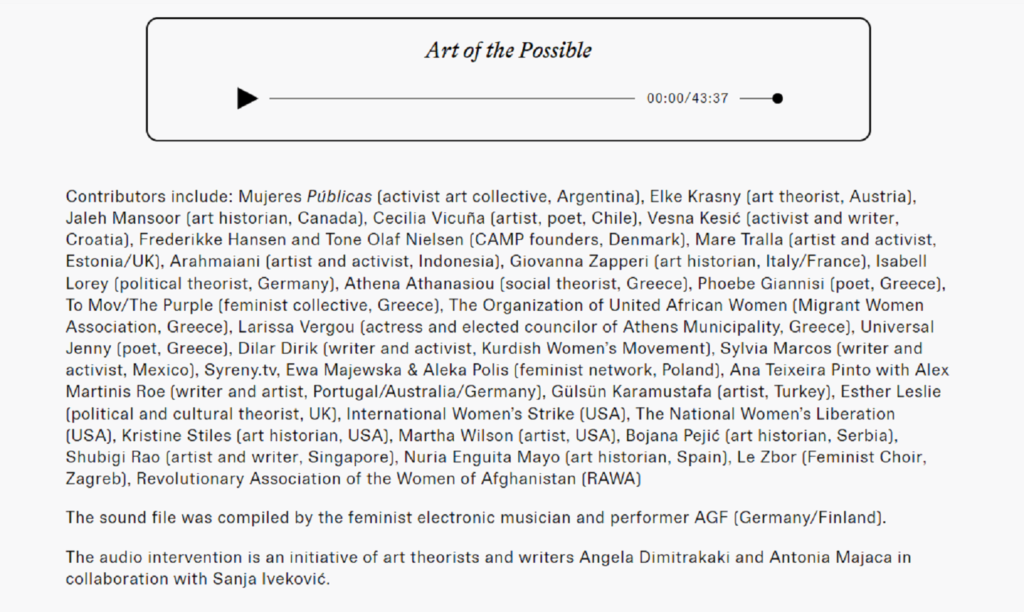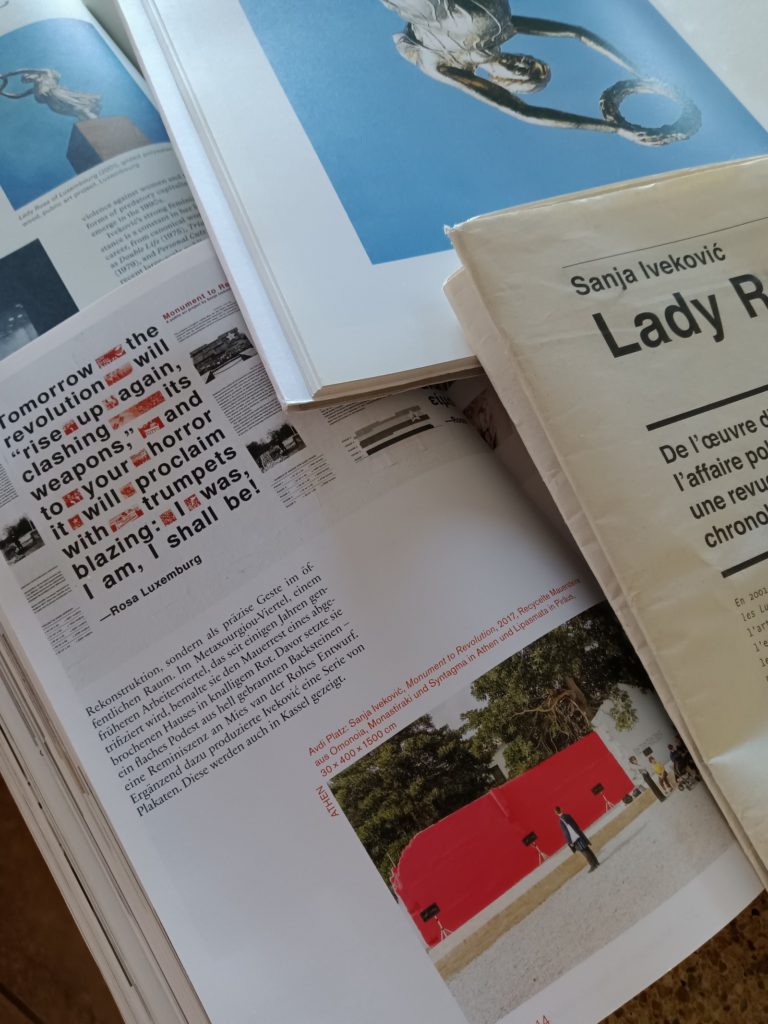—Antonia Majaca, ‘Sanja Iveković’ in The documenta 14 Daybook (2017)
Side A: Lady R by Sofia Mavragani
Inspired by the last speech of Rosa Luxemburg, Lady R takes place in the context of the public art project Monument to Revolution by Sanja Iveković.
Created by Sofia Mavragani, performed by Chara Kotsali, original music of Martha Mavroidi
Performance text
[Extracts from the last known piece of writing by Rosa Luxemburg. It was written just after the Spartacus uprising was crushed by the German government and in the hours prior to the arrest and murder of her and Karl Liebknecht by the Friekorps.]
“Order prevails in Warsaw!” “Order prevails in Paris!” “Order prevails in Berlin!” Every half-century that is what the bulletins from the guardians of “order” proclaim from one centre of the world-historic struggle to the next. And the jubilant “victors” fail to notice that any “order” that needs to be regularly maintained through bloody slaughter heads inexorably toward its historic destiny; its own demise.
While we are still in the midst of battle, while the counterrevolution is still howling about their victory, revolutionists must take stock of what happened and measure the events and their results against the great yardstick of history. The revolution has no time to lose, it continues to rush headlong over still-open graves, past “victories” and “defeats,” toward its great goal. The first duty of fighters is to consciously follow the revolution’s principles and its path.
The revolution does not develop evenly of its own volition, in a clear field of battle, according to a cunning plan devised by clever “strategists.”
The revolution’s enemies can also take the initiative, and indeed as a rule they exercise it more frequently than does the revolution. Indeed, the honour of the revolution depended upon repelling the attack immediately, with full force in order to prevent the counter-revolution from being encouraged to press forward, and lest the revolutionary ranks be shaken.
Now, it is one of the fundamental, inner laws of revolution that it never stands still, it never becomes passive or docile at any stage, once the first step has been taken. The best defence is a strong blow. This is the elementary rule of any fight but it is especially true at each and every stage of the revolution.
Here again we stand before one of the great historical laws of the revolution against which are smashed to pieces all the sophistry and arrogance of the petty “revolutionaries” who look for any pretext to the petty “revolutionaries” who look for any pretext to retreat from struggle. As soon as the fundamental problem of the revolution has been clearly posed then this basic problem will rise again and again in its entirety. With the inevitability of a natural law, every individual chapter in the struggle will unveil this problem to its full extent regardless of how unprepared the revolution is ready to solve it or how unripe the situation may be. Thus automatically, by its own internal, objective logic, bringing each episode in the struggle to a boil, whether one wants it to or not.
Because of the contradiction in the early stages of the revolutionary process between the task being sharply posed and the absence of any preconditions to resolve it, individual battles of the revolution end in formal defeat. But revolution is the only form of “war” – and this is another peculiar law of history – in which the ultimate victory can be prepared only by a series of “defeats.”
What does the entire history of all modern revolutions show us? The first spark of class struggle in Europe, the revolt of the silk weavers in Lyon in 1831, ended with a heavy defeat; the Chartist movement in Britain ended in defeat; the uprising of the Parisian proletariat in the June days of 1848 ended with a crushing defeat; and the Paris commune ended with a terrible defeat. The whole road of revolutionary struggles is paved with nothing but thunderous defeats. Yet, at the same time, history marches inexorably, step by step, toward final victory!
Where would we be today without those “defeats”?
There is but one condition. The question of why each defeat occurred must be answered. Did it occur because the forward-storming combative energy of the masses collided with the barrier of unripe historical conditions, or was it that indecision, vacillation, and internal frailty crippled the revolutionary impulse itself?
Both! The crisis had a dual nature.
“Order prevails in Athens!” “Order prevails in Kassel!” You foolish lackeys! Your “order” is built on sand. Tomorrow the revolution will “rise up again, clashing its weapons,” and to your horror it will proclaim with trumpets blazing:
I was, I am, I shall be!
Side B: Art of the Possible: Towards an Antifascist Feminist Front: An initiative of Angela Dimitrakaki and Antonia Majaca in collaboration with Sanja Iveković
Visitors to Sanja Ivekovic’s public art project Monument to Revolution in central Athens encounter a collective oral document in which women from diverse contexts and backgrounds respond to the imagining of an international Anti-fascist Feminist Front. Envisioned as a prefigurative political positioning, this gathering of voices foregrounds the need for a broad, coalitional feminism against the current fascist offensive witnessed in many parts of the world. The contributors speak in different languages –their mother tongues or the languages in which their thinking and acting is shaped– and yet they speak in common. Women involved in cultural or political critique, women involved in activism, women making art and writing poetry, women –above all– that experience feminism as a revolutionary political horizon incompatible with the misery and oppression of contemporary capitalism, and the political monsters it is generating, assemble in spirit taking their cue from the dynamism of strategic feminist militancy.
Sanja Iveković’s work, hosted by documenta 14, re-imagines Ludwig Mies van der Rohe’s Monument to Rosa Luxemburg and Karl Liebknecht (Monument to the November Revolution) built in Berlin in 1926 and destroyed by the Nazis in the 1930s, representing a second death of the two revolutionaries who were murdered in 1919 by the proto-Nazi Freikorps. The audio intervention takes place at the site where the temporary re-materialisation of the base of this historic monument stands as a challenge to the normalised excision both of female revolutionary leaders and the memory of insurrections from urban space. The audio document is inspired by Rosa Luxemburg’s definition of transformative political praxis in terms of an ‘art of the possible’: “our practical struggle become[s] what it must be: the realisation of our basic principles in the process of social life and the embodiment of our general principles in practical every day action. And only under these conditions do we fight in the sole permissible way for what is at any time ‘possible’.” Following in her steps, the women’s responses to Monument to Revolution and the possibility of an international antifascist feminist front indicate a framework for action within our historically specific conditions of urgency without forgetting the vigilant solidarity underpinning the feminist struggle as such.


